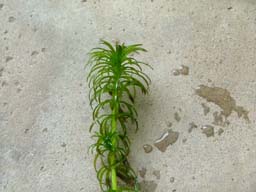Nick Acheson
April 29, 2010
An environmental issue that is becoming increasingly more important, especially in Maine, is the spread of invasive aquatic plant species. Invasive species can be plants, animals, or microbes that are introduced from other regions and aggressively out-compete the native species. When spread, these plant species takeover any body of water and multiply exponentially so in only a short time the lake, stream or pond becomes engulfed in invasive plants.
These plants are usually spread by recreational activities such as the transportation of boats and boating gear, illegal fish stocking, and even fishing lures and/or gear can be enough to “infect” a body of water. These invasive plants can ruin an ecosystem by reducing fish movement, stunting growth, crowding out native plants, and shading out the bottom which reduces the amount of other useful animals such as snails. In some cases it can even change the water chemistry in very dense plant beds.

Currently Maine is host to 45 or more invasive aquatic species which includes ocean species as well as freshwater species. These invasive species include Eurasian milfoil, variable milfoil, fanwort, water chestnut, curly-leaf pondweed, and hydrilla. There are 25 documented bodies of water in Maine that have invasive milfoil, the most common type of invasive species. Last September the Maine Department of Environmental Protection (DEP) confirmed that Damariscotta Lake in Jefferson had hydrilla which is the most aggressive invasive plant species in North America.
The Maine DEP along with the Maine Department of Inland Fisheries and Wildlife (DIFW) and other agencies are working to make sure they eradicate any new infestations by educating people how these plants are spread, and what to do if you find them. Since there are only about 25 infected lakes and ponds out of the total amount of 6,000, “prevention is the most practical option available for protecting Maine inland water bodies,” according to the Maine DEP website.
Additional information can found at the Maine DEP and Maine DIFW websites.
April 29, 2010
An environmental issue that is becoming increasingly more important, especially in Maine, is the spread of invasive aquatic plant species. Invasive species can be plants, animals, or microbes that are introduced from other regions and aggressively out-compete the native species. When spread, these plant species takeover any body of water and multiply exponentially so in only a short time the lake, stream or pond becomes engulfed in invasive plants.
These plants are usually spread by recreational activities such as the transportation of boats and boating gear, illegal fish stocking, and even fishing lures and/or gear can be enough to “infect” a body of water. These invasive plants can ruin an ecosystem by reducing fish movement, stunting growth, crowding out native plants, and shading out the bottom which reduces the amount of other useful animals such as snails. In some cases it can even change the water chemistry in very dense plant beds.

Currently Maine is host to 45 or more invasive aquatic species which includes ocean species as well as freshwater species. These invasive species include Eurasian milfoil, variable milfoil, fanwort, water chestnut, curly-leaf pondweed, and hydrilla. There are 25 documented bodies of water in Maine that have invasive milfoil, the most common type of invasive species. Last September the Maine Department of Environmental Protection (DEP) confirmed that Damariscotta Lake in Jefferson had hydrilla which is the most aggressive invasive plant species in North America.
The Maine DEP along with the Maine Department of Inland Fisheries and Wildlife (DIFW) and other agencies are working to make sure they eradicate any new infestations by educating people how these plants are spread, and what to do if you find them. Since there are only about 25 infected lakes and ponds out of the total amount of 6,000, “prevention is the most practical option available for protecting Maine inland water bodies,” according to the Maine DEP website.
Additional information can found at the Maine DEP and Maine DIFW websites.

Sources:
http://maine.gov/dep/blwq/topic/invasives/invsticker.htm
http://maine.gov/dep/blwq/topic/invasives/rrp_part1final.pdf
http://maine.gov/dep/blwq/topic/invasives/rrp_part2final.pdf
http://plants.usda.gov/java/profile?symbol=MYSP2
http://en.wikipedia.org/wiki/Hydrilla_verticillata
http://maine.gov/dep/blwq/topic/invasives/eurapic2.jpg
http://upload.wikimedia.org/wikipedia/commons/1/1c/Plant_-_Hydrilla_verticillata_-_Batu_kawa.jpg
http://www.maine.gov/dep/blwq/doclake/boaters.jpg
http://maine.gov/dep/blwq/topic/invasives/fanpic2.jpg
http://maine.gov/dep/blwq/topic/invasives/chespic2.jpg


